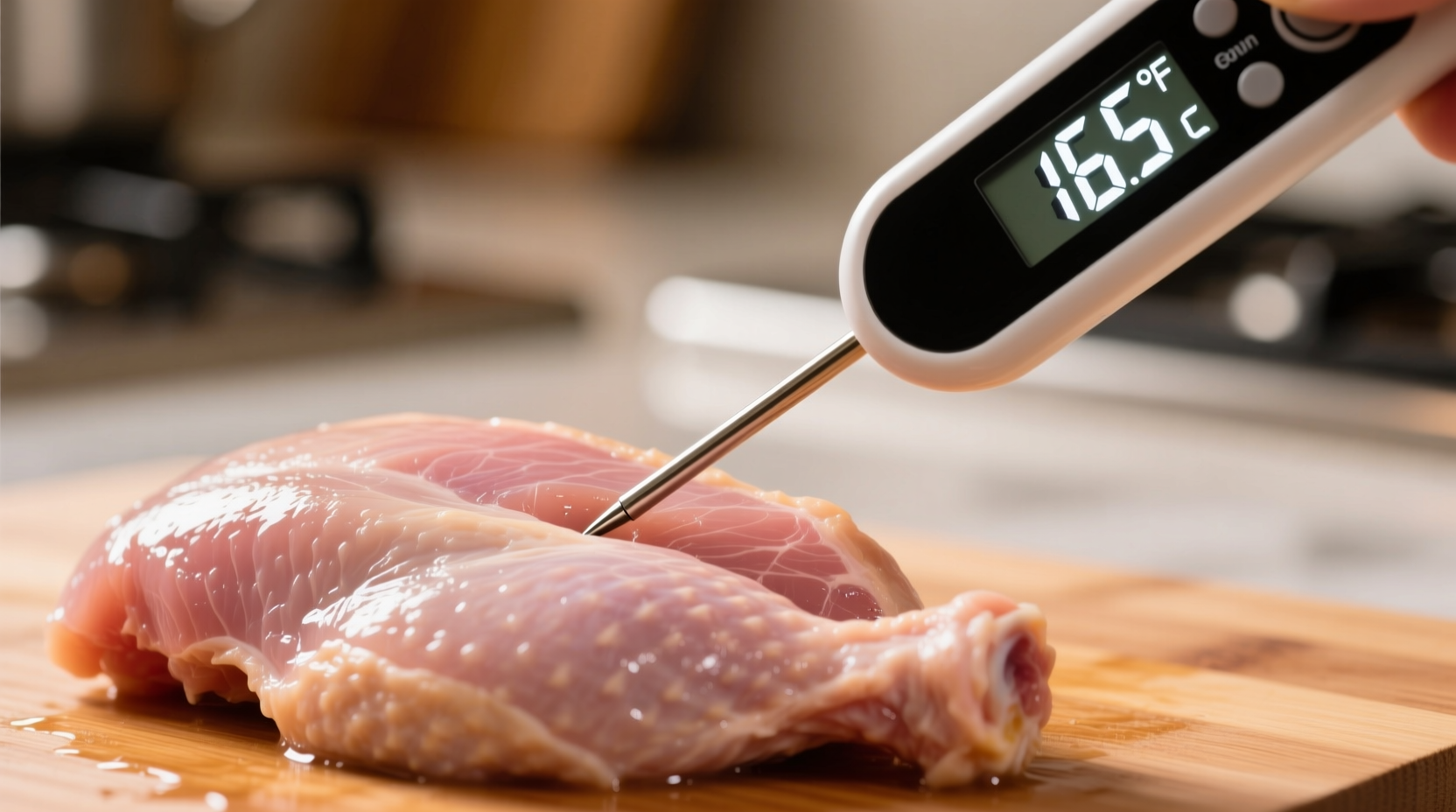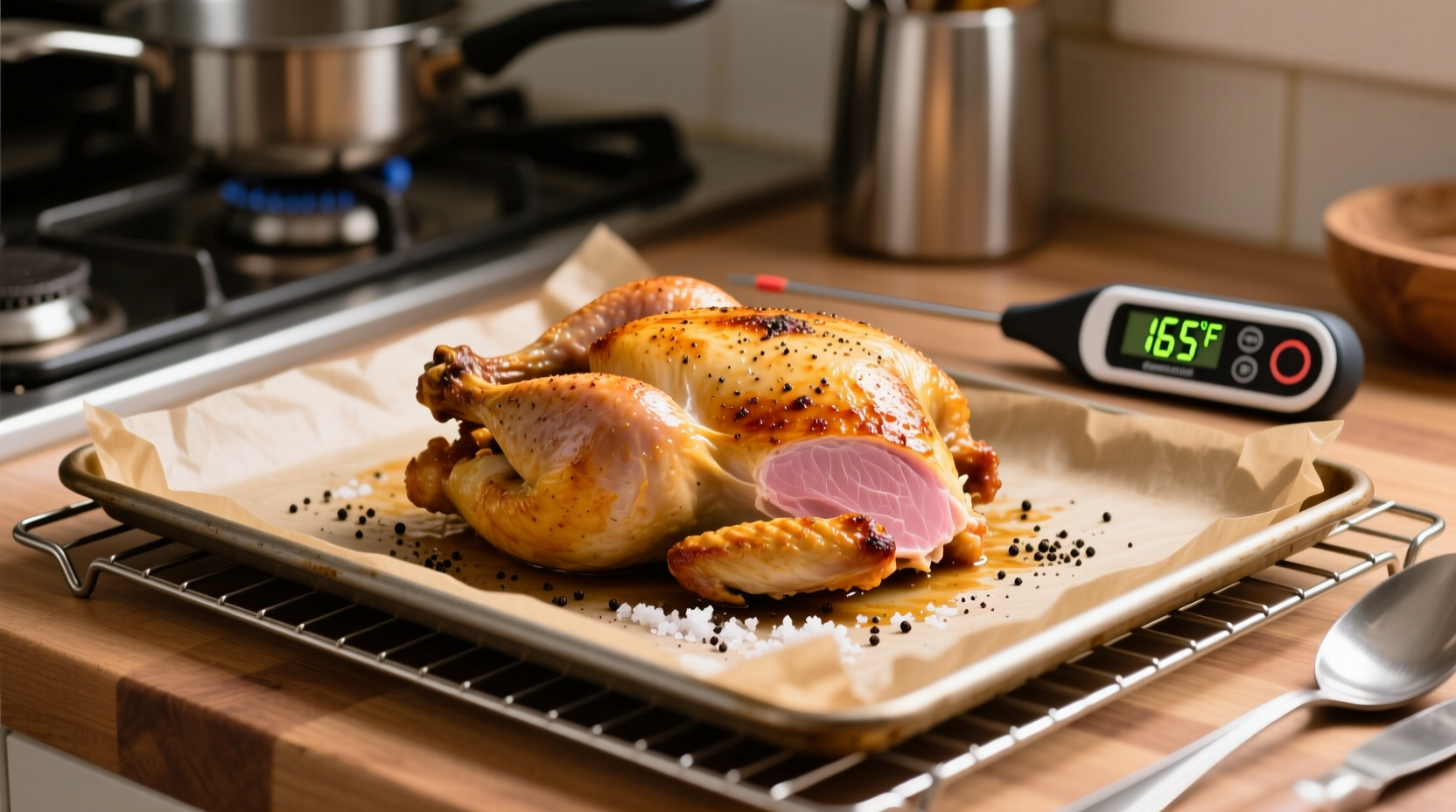Getting chicken temperature right isn't just about safety—it's the difference between juicy perfection and dry disappointment. While 165°F remains the gold standard for food safety, understanding the science behind this number helps you cook better chicken every time.
Why 165°F Is Non-Negotiable for Safety
Chicken naturally contains pathogens that can cause serious foodborne illness. The USDA's Food Safety and Inspection Service confirms that 165°F (74°C) is the temperature at which salmonella bacteria are instantly destroyed. This isn't arbitrary—it's based on extensive food safety research documented in the USDA's Chicken and Food Safety guidelines.
| Temperature | Time to Eliminate Salmonella | Practical Application |
|---|---|---|
| 165°F (74°C) | Instant | Standard recommendation for all chicken |
| 150°F (66°C) | 2.8 minutes | Sous vide cooking only |
| 140°F (60°C) | 26 minutes | Specialized techniques only |
This evidence-based timeline shows why instant-read thermometers are essential—they confirm when chicken reaches the critical 165°F threshold. While some chefs use lower temperatures for specific techniques like sous vide (with precise timing), the USDA maintains 165°F as the universal standard for conventional cooking methods.
Proper Temperature Measurement Techniques
Many home cooks make critical errors when checking chicken temperature:
- Wrong placement: Insert your thermometer into the thickest part of the meat, avoiding bones which give false readings
- Single-point testing: Check multiple spots in larger cuts like whole chickens
- Early removal: Pull chicken from heat when it reaches 160-162°F—the temperature will rise 3-5°F during resting

Temperature Variations by Chicken Cut
While 165°F applies universally, different cuts require different approaches:
- Chicken breasts: Cook to 160°F then rest—breasts dry out quickly past 165°F
- Thighs and drumsticks: Can safely reach 170-175°F for more tender results as dark meat benefits from higher temperatures
- Whole chicken: Check both breast and thigh areas—the bird is done when both reach minimum temperatures
The FDA Food Code specifies these standards to prevent foodborne illness outbreaks. Remember that color isn't a reliable indicator—properly cooked chicken can still appear slightly pink near bones due to myoglobin.
Troubleshooting Common Temperature Issues
Dry chicken at proper temperature? This usually happens from overcooking after removal from heat. Try pulling chicken at 160°F and allowing carryover cooking during the 5-10 minute rest period.
No thermometer available? While not recommended, you can check by piercing the thickest part—juices should run clear with no pink tinge. However, the National Chicken Council emphasizes that only a food thermometer provides accurate safety verification.
Undercooked chicken discovered after serving? Return to heat immediately until reaching 165°F. Never serve undercooked poultry, as bacteria can survive below this threshold.
Essential Tools for Perfect Chicken Every Time
Invest in these temperature-critical tools:
- Digital instant-read thermometer: Provides accurate readings in 3-5 seconds (Thermoworks MK4 is industry standard)
- Leave-in probe thermometer: Monitors temperature continuously during roasting
- Calibration tools: Ice water (32°F/0°C) and boiling water (212°F/100°C at sea level) tests ensure accuracy
Regular thermometer calibration matters—studies show improperly calibrated thermometers contribute to 23% of home cooking temperature errors according to FoodSafety.gov data.
Final Temperature Checklist
- Use a calibrated digital thermometer
- Check thickest part without touching bone
- Verify 165°F minimum in all sections
- Allow 5-10 minutes resting time
- Clean thermometer with hot soapy water after each use
Following these evidence-based temperature guidelines ensures your chicken is both safe to eat and perfectly cooked. While cooking times vary by method and equipment, temperature remains the only reliable indicator of doneness and safety.
Can chicken be safe at 160 degrees?
Chicken reaches safe consumption at 165°F (74°C) according to USDA guidelines. At 160°F, salmonella requires 14 seconds to be eliminated, making it unsafe for conventional cooking methods. Only sous vide cooking with precise timing can safely use lower temperatures.
How long should chicken rest after reaching 165 degrees?
Chicken should rest for 5-10 minutes after reaching 165°F. During this time, the temperature remains above 160°F while juices redistribute, resulting in more tender meat. The internal temperature typically rises 3-5°F during resting due to carryover cooking.
Why is my chicken dry even at 165 degrees?
Chicken breasts often become dry when cooked to 165°F because white meat has less fat. For juicier results, remove chicken from heat at 160°F and allow carryover cooking during resting. Dark meat (thighs, drumsticks) can safely reach 170-175°F for more tender results as it contains more connective tissue.
Does chicken continue cooking after removal from heat?
Yes, chicken continues cooking after removal from heat due to residual heat, known as carryover cooking. The internal temperature typically rises 3-5°F during the recommended 5-10 minute resting period. This is why many chefs recommend removing chicken from heat at 160-162°F to reach the perfect 165°F final temperature.
How accurate do chicken thermometers need to be?
Food thermometers should be accurate within ±2°F for safe chicken cooking. Calibrate regularly using ice water (32°F/0°C) and boiling water (212°F/100°C at sea level) tests. The USDA recommends checking thermometer accuracy before each use, as even small errors can result in unsafe food temperatures.











 浙公网安备
33010002000092号
浙公网安备
33010002000092号 浙B2-20120091-4
浙B2-20120091-4